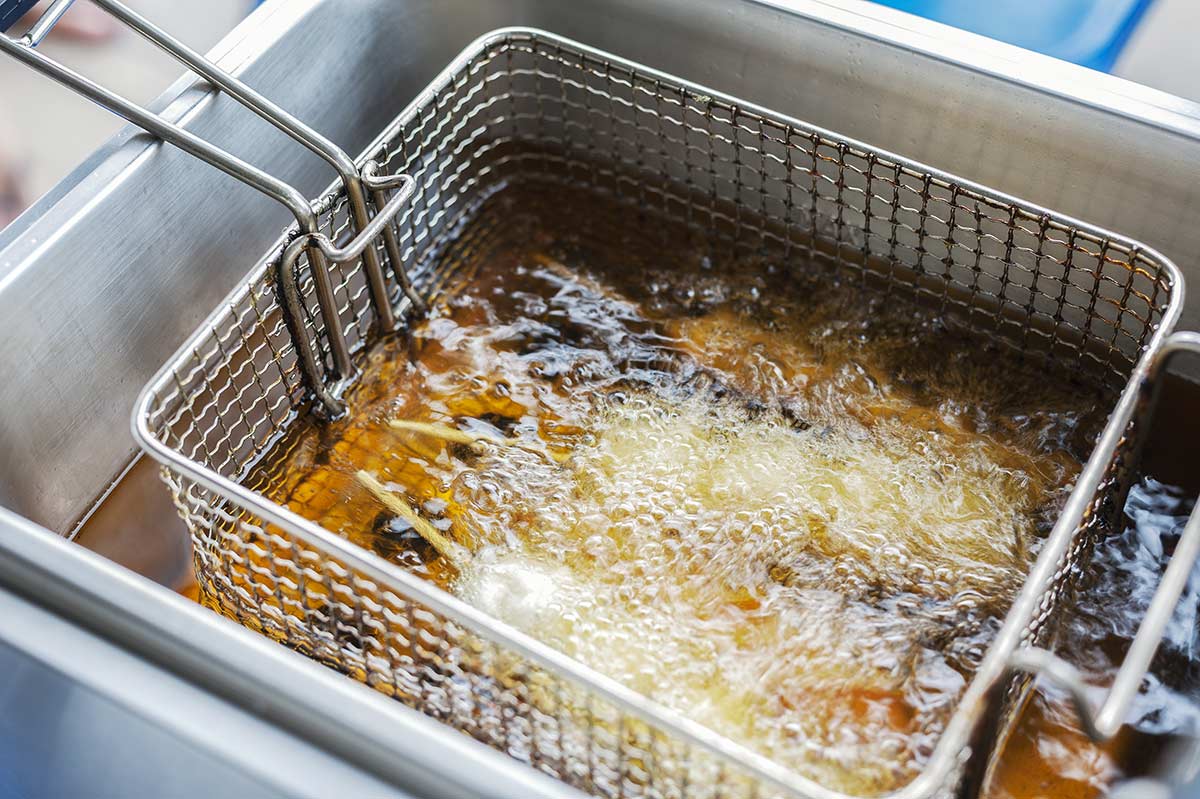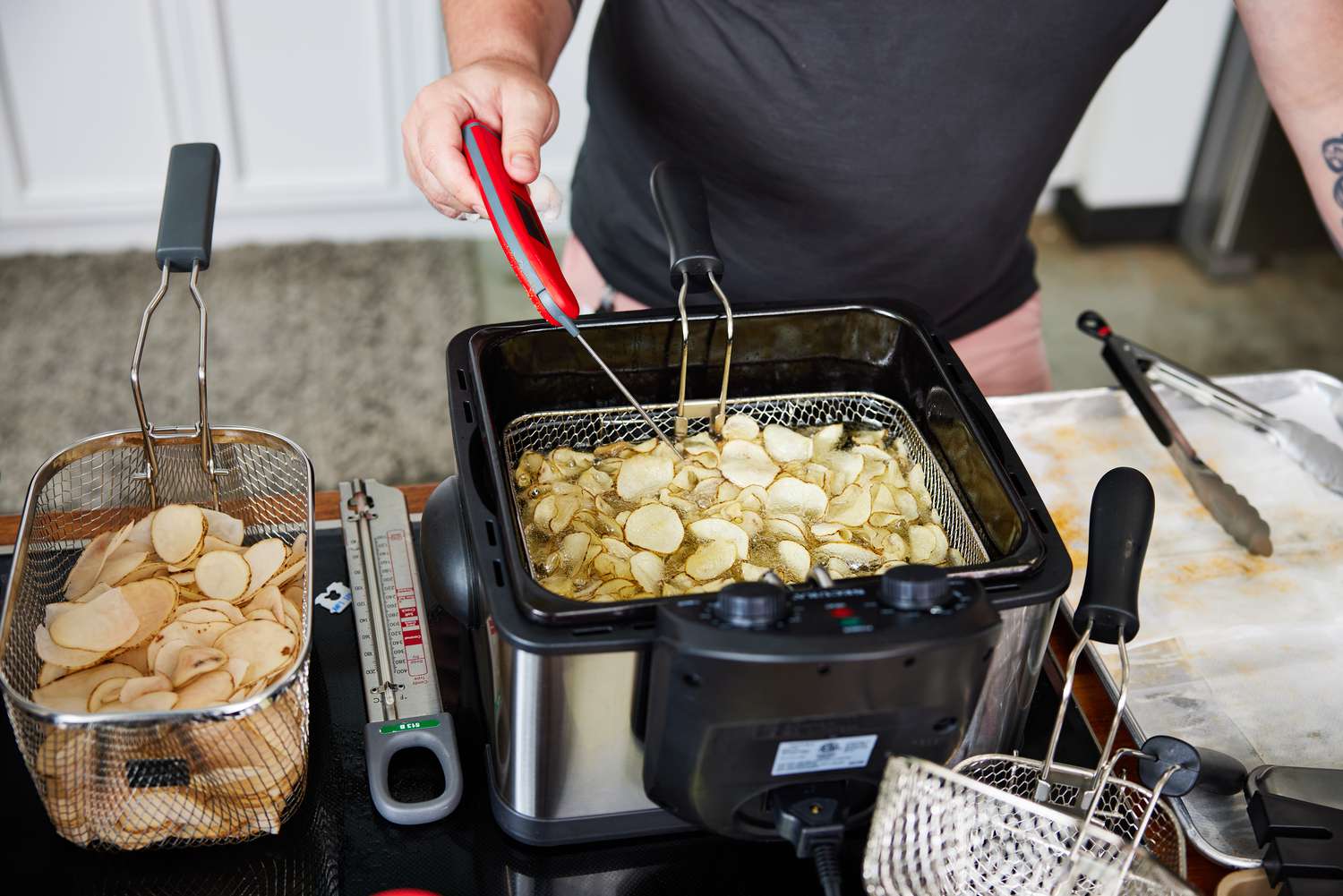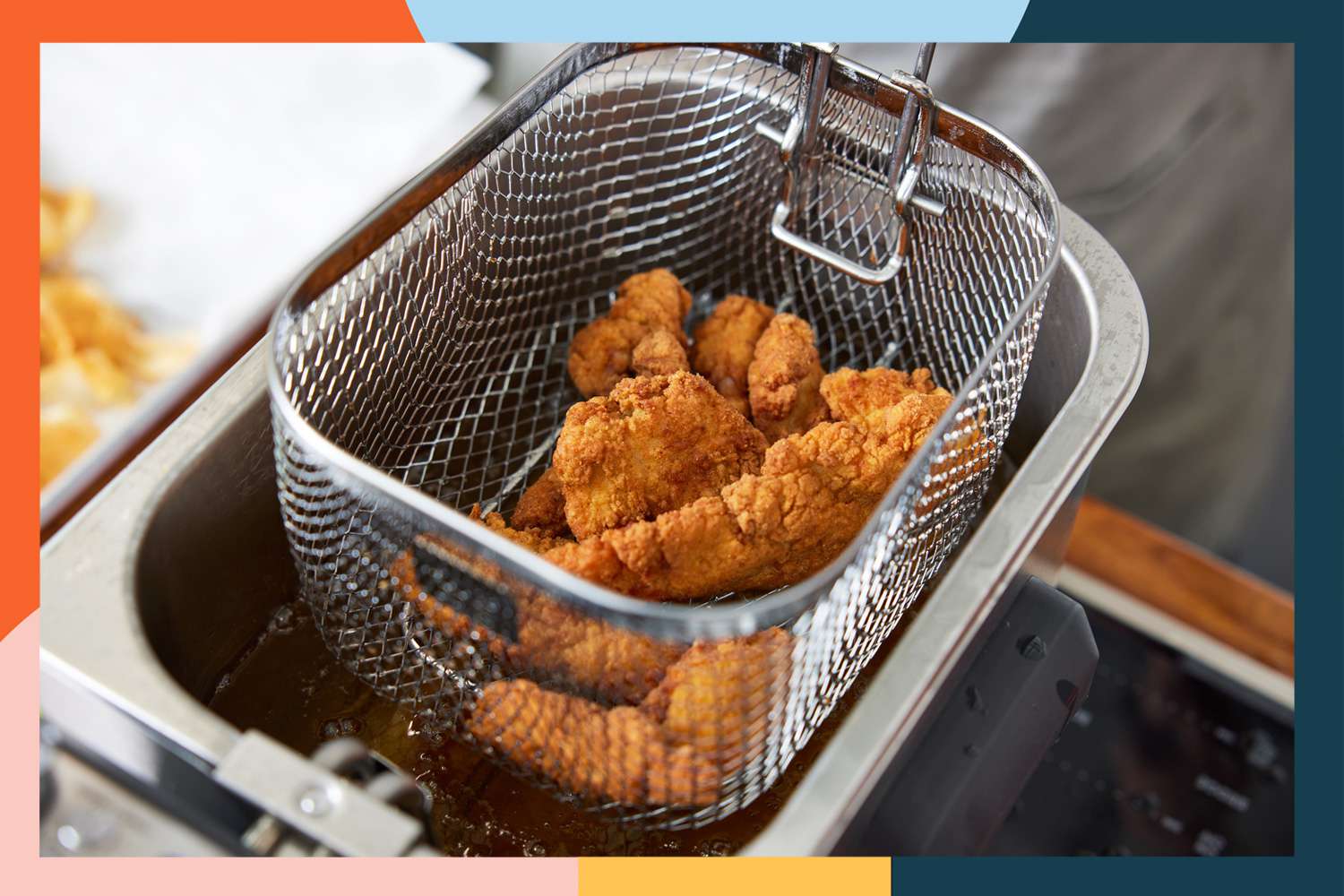Crispy Alchemy: Deep Fryer Delights Unveiled
Explore the enchanting world of deep fryers, where culinary magic turns ordinary dishes into crispy perfection. From electric wonders to outdoor propane companions, discover the benefits, safety tips, and the secret to extending the life of your frying oil.
Unveiling the Culinary Magic of Deep Fryers: Benefits, Safety Tips, and Oil Longevity

A deep fryer is a kitchen appliance designed for the art of submersion cooking. It involves immersing food in hot oil, creating a crispy exterior while locking in succulent flavors. From golden fries to crispy chicken, the deep fryer transforms ordinary ingredients into extraordinary indulgences.
Types of Deep Fryers:
- Electric Deep Fryers:
- Compact and versatile, electric fryers are suitable for home kitchens. They feature adjustable temperature controls and are easy to use, making them a popular choice for frying favorites like fries and wings.
- Propane Deep Fryers:
- Outdoor enthusiasts and event caterers favor propane fryers. Ideal for large quantities, these fryers are perfect for backyard gatherings, festivals, and tailgate parties.
- Air Fryers:
- A modern twist on deep frying, air fryers use hot air circulation to achieve a crispy texture with significantly less oil. Health-conscious cooks appreciate this option for guilt-free indulgence.
- Commercial Deep Fryers:
- Powerhouses in professional kitchens, commercial fryers are designed for high-volume cooking. They feature advanced temperature controls and durable construction to withstand constant use in restaurants and food establishments.
Benefits of Deep Fryers:
- Speed and Efficiency:
- Deep fryers cook food quickly, making them perfect for busy households or when entertaining guests. The rapid cooking process seals in flavors and moisture.
- Crispy Perfection:
- Achieving that coveted crispy texture is a forte of the deep fryer. From onion rings to donuts, it brings a delightful crunch to a variety of dishes.
- Versatility in Cooking:
- Deep fryers are versatile, accommodating an array of foods—from appetizers to main courses to desserts. Explore the possibilities of frying vegetables, seafood, and even desserts like churros.
- Temperature Control:
- Many deep fryers offer precise temperature control, ensuring consistent results. This feature allows users to adjust the heat according to the type of food being fried, preventing overcooking or undercooking.
- Easy Cleanup:
- Removable components and non-stick surfaces make deep fryers a breeze to clean. The efficient design minimizes mess and hassle, encouraging more frequent use.
FAQ
Does deep fryer use oil?
Yes, deep fryers use oil as the cooking medium. The process of deep frying involves submerging food in hot oil, cooking it quickly and creating a crispy exterior. The type of oil used can vary, and different oils have different smoke points, which is the temperature at which the oil begins to break down and produce smoke.
Commonly used oils in deep fryers include:
- Vegetable Oil: This is a popular choice for deep frying due to its neutral flavor and high smoke point.
- Canola Oil: Canola oil is another vegetable oil with a high smoke point, making it suitable for deep frying. It is often chosen for its mild taste.
- Peanut Oil: Peanut oil has a high smoke point and imparts a distinct flavor to the fried food. It is often used in Asian cuisine.
- Sunflower Oil: Sunflower oil is a versatile option with a moderate to high smoke point, making it suitable for various deep-frying applications.
- Corn Oil: Corn oil has a high smoke point and is commonly used for deep frying.
How long can oil stay in deep fryer?
The longevity of oil in a deep fryer depends on several factors, including the type of oil used, the temperature at which it's heated, the types of foods being fried, and how well the oil is maintained. Here are some general guidelines:
- Type of Oil:
- Oils with higher smoke points, such as peanut oil, canola oil, or vegetable oil, tend to last longer than oils with lower smoke points. These oils are more stable at high temperatures.
- Temperature:
- The temperature at which the oil is heated during frying affects its lifespan. Higher frying temperatures can lead to faster oil degradation.
- Foods Fried:
- The type of food being fried also impacts the lifespan of the oil. Foods with coatings or batters may leave more residue in the oil, contributing to quicker breakdown.
- Filtration and Cleaning:
- Regular filtration and cleaning of the oil can extend its usability. Filtering removes food particles and impurities, helping to maintain the quality of the oil.
- Oil Quality Monitoring:
- Keep an eye on the color, odor, and flavor of the oil. Once the oil starts to develop a rancid smell, dark color, or off-flavor, it is an indication that it has reached the end of its useful life.
- Frequency of Use:
- If the deep fryer is used frequently, the oil may need to be replaced more often. Regular use exposes the oil to repeated heating and cooling cycles, which can contribute to faster degradation.
As a general guideline, oil in a deep fryer can typically be used for about 8 to 10 uses, or even longer under optimal conditions. However, it's essential to monitor the oil's quality and follow the manufacturer's recommendations for oil replacement.
To extend the life of the oil:
- Filter the oil regularly: Use a fine-mesh strainer or a filtering system to remove food particles and impurities.
- Store the oil properly: Keep the oil in a cool, dark place, away from heat sources and direct sunlight.
- Avoid mixing oils: If you're adding fresh oil to the fryer, try to use the same type of oil to maintain consistency.
Is deep fryer healthy?
The healthiness of deep-fried food depends on several factors, including the type of oil used, the cooking temperature, and the frequency of consumption. While deep-frying is often associated with indulgent, crispy treats, it's essential to be mindful of certain health considerations:
1. Choice of Oil:
- Opt for healthier oils with higher smoke points, such as vegetable oil, canola oil, or peanut oil. These oils are more stable at high temperatures and are less likely to break down into harmful compounds.
2. Temperature Control:
- Maintaining the correct frying temperature is crucial. Cooking at the recommended temperature ensures that the food cooks quickly, minimizing oil absorption and preventing it from becoming greasy.
3. Moderation:
- Like many indulgent foods, deep-fried items are best enjoyed in moderation. Frequent consumption of fried foods, even if cooked with healthier oils, can contribute to an excessive intake of calories and unhealthy fats.
4. Nutrient Retention:
- Deep-frying can cause some loss of water-soluble vitamins in certain foods. However, it's worth noting that the impact on nutrient loss varies depending on the type of food and the cooking time.
5. Alternative Cooking Methods:
- Consider alternative cooking methods like baking, grilling, or air frying for a healthier approach. Air fryers, in particular, use significantly less oil than traditional deep fryers, resulting in lower fat content in the finished dishes.
6. Choose Leaner Cuts:
- Opt for lean cuts of meat or vegetables when deep-frying. This reduces the overall fat content of the dish.
7. Drain Excess Oil:
- After deep-frying, place the cooked food on paper towels to absorb excess oil.
While deep-frying can be enjoyed as an occasional treat, it's important to balance it with a diet rich in fruits, vegetables, whole grains, and lean proteins. As with any cooking method, the key is moderation and making conscious choices about the type and amount of oil used, as well as the frequency of consumption.
What equipment is used for deep frying?
Several pieces of equipment are commonly used for deep frying. These include:
- Deep Fryer:
- A dedicated deep fryer is an electric appliance specifically designed for frying. It typically consists of a heating element, a temperature control system, and a frying basket. Some models may have additional features such as oil filtration systems.
- Fryer Pot and Thermometer:
- A deep, heavy-bottomed pot, such as a Dutch oven or a deep saucepan, can be used for deep frying on the stovetop. A deep-fry thermometer is essential to monitor and maintain the oil temperature.
- Frying Basket:
- A metal or mesh basket with a handle is used to safely lower food into hot oil and lift it out when cooking is complete. The basket allows oil to drain off the food.
- Spider Strainer or Slotted Spoon:
- A spider strainer or a slotted spoon is useful for removing fried items from the hot oil. It allows excess oil to drain off as you lift the food.
- Oil Thermometer:
- To ensure that the oil reaches and maintains the correct temperature, an oil thermometer is essential. It helps prevent undercooking or overcooking and ensures optimal frying results.
- Oil Filter or Cheesecloth:
- After multiple uses, it's important to filter and clean the frying oil to remove impurities. An oil filter or a fine-mesh cheesecloth can be used for this purpose.
- Cooling Rack:
- Placing fried items on a cooling rack after removing them from the oil allows any remaining oil to drain away and helps maintain their crispiness.
- Paper Towels:
- Placing fried items on paper towels absorbs excess oil, contributing to a less greasy texture.
- Tongs:
- Tongs are useful for flipping or turning food in the hot oil, ensuring even cooking.
- Lid or Splatter Guard:
- A lid or splatter guard can be used to cover the pot partially during frying, reducing splatter and mess.
- Fire Extinguisher:
- While not directly related to the cooking process, it's important to have a fire extinguisher in the kitchen as a safety precaution when working with hot oil.
What is the difference between frying and deep frying?
"Frying" and "deep frying" both involve cooking food in hot oil, but there are differences in the techniques and applications of these cooking methods.
1. Depth of Oil:
- Frying: In general frying, a smaller amount of oil is used, and the food is partially submerged or cooked in a shallow layer of oil. It can involve pan-frying, stir-frying, or sautéing.
- Deep Frying: Deep frying, on the other hand, requires a larger quantity of oil. The food is fully submerged in the hot oil, allowing it to cook quickly and evenly.
2. Cooking Method:
- Frying: In frying, the food is usually cooked by direct contact with the hot surface of the pan or a minimal amount of oil. It may involve flipping or turning the food to ensure even cooking.
- Deep Frying: Deep frying involves complete submersion of the food in hot oil. The food is fully surrounded by the oil, leading to a crisp and evenly cooked exterior.
3. Typical Foods:
- Frying: Frying is commonly used for foods that don't require deep immersion, such as eggs, pancakes, vegetables, or smaller cuts of meat.
- Deep Frying: Deep frying is suitable for foods that benefit from a crispy exterior, such as french fries, chicken wings, onion rings, or battered and breaded items.
4. Oil Temperature:
- Frying: Frying may be done at various temperature ranges depending on the specific technique. For example, stir-frying often involves high heat, while pan-frying may be done at a medium temperature.
- Deep Frying: Deep frying typically requires higher temperatures to quickly cook the food and create the desired crispiness. The oil temperature is usually between 350°F to 375°F (177°C to 190°C).
5. Cooking Time:
- Frying: Frying times can vary based on the specific food and technique. It may involve shorter cooking times compared to deep frying.
- Deep Frying: Deep frying is known for its shorter cooking times due to the high temperature and full submersion of the food in the oil.
A deep fryer is a kitchen appliance designed for the culinary art of submersion cooking, immersing food in hot oil to achieve a crispy exterior. It comes in various types, including electric, propane, air fryers, and commercial models. The benefits of deep frying include speed, crispy perfection, versatility, temperature control, and easy cleanup. To ensure safe use, it's crucial to choose the right location, use the correct type of oil, monitor temperature, avoid overcrowding, and keep children and pets at a safe distance. The longevity of oil in a deep fryer depends on factors such as the type of oil, temperature, foods fried, and proper maintenance, with the oil typically lasting for 8 to 10 uses under optimal conditions.








